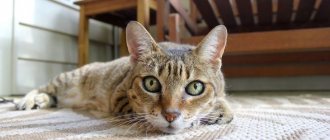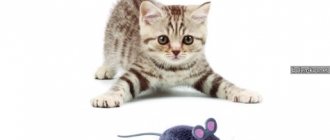Advantages and disadvantages of leashes
Pros:
- Carrying out walks, knowing that the animal will not run away;
- Control over your pet, the ability to avoid hard-to-reach or dangerous places, exclusion of unwanted situations (meeting stray dogs and cats);
- The risk of losing an animal is significantly reduced. He is constantly in sight, which will prevent him from eating anything on the street, jumping into garbage cans, and so on;
- Adjusting the distance between the owner and the pet;
- Just for the peace of mind of the owner himself.
Minuses:
- Not all cats quickly get used to leashes. They may panic, try to break free and run away, and in an agitated and nervous state, the cat may harm itself;
- Incorrectly chosen leashes injure animals, severely squeezing the neck;
- Poor quality leashes can break at any time, and it is possible that the cat, taking advantage of this, will run away and get lost.
Stress
All cats experience negative experiences on their first walks. This is fine. If you sat inside four walls all your life and didn’t know that there was a world around you, you would be scared too. In addition, cats have a heightened sense of hearing and smell, and therefore new sounds and smells of the street seem stronger to them than to us, which is also frightening and stressful at first. But over time, everything changes - and the cat, who hated the street, suddenly begins to love it, because he understands: it’s interesting, it smells nice, it gives new vivid impressions.
With the right approach, which starts with taking the cat in a carrier or in a special space backpack out into the yard for 5 minutes, almost any animal can be taught to love walks. To do this you will need from 1 to 10 outputs. But there always remains a small percentage of those who are against it, even despite regular appearances. It’s probably better to leave them at home and not force them: if the animal experiences negative stress every time during a walk, this will not bring anything good - then let it breathe the air while sitting on the windowsill.
When not to use a harness
- Walking an old cat that is not leash-trained can be a stressful situation for her, which will negatively affect her health;
- A harness for walking a small kitten requires careful selection due to its rapid growth;
Harnesses are not recommended for pregnant cats, or after surgical procedures, or for cats with physiological defects.
How to choose a cat harness
The device consists of straps with metal rings, a leash lock and a latch fastening. A cat harness should, firstly, be comfortable for the pet and practical for the owner. And secondly - inexpensive, made of high-quality materials and with reliable fastenings.
The size of the “collar” is determined by the circumference of the chest - just above the center of the body, behind the front legs. Knowing the length of this parameter in centimeters, choosing a harness will not be difficult.
What features of a cat leash are worth paying attention to:
- the cat harness should be made of practical and durable materials - thick fabric or soft natural leather;
- with elastic straps no more than 1.5 cm wide, which will ensure a comfortable fit and perfect fixation of the straps;
- with reflective stitching, and sometimes with patterns, but the harness should not be afraid of washing and cleaning, even daily, and should not lose its appearance and density;
- A comfortable cat harness fits snugly without squeezing your pet's neck.
Purpose of collars
Collars are purchased in particular for anti-parasitic purposes, as well as in case the animal gets lost or something happens to it. A medallion is attached indicating the cat's name, owner's phone number or address.
This is interesting
Many cats love to walk so much that their owners manage to take them with them even to the sea or to the mountains. The cat named Paul has already visited many places with his owners, and recently conquered Mount Grays Peak, 4350 m high.
The McMillen family captures all the adventures of the gallant and brave cat and posts the photographs on the Internet. The cat is not afraid of living creatures, swims with pleasure and can withstand long walks.
Types of harnesses
The essence of cat leashes is to attach the leash to straps that go around the cat's body, which allows you to do without a collar.
They differ in mounting methods:
- Eights. They consist of a pair of loops that are attached to the neck and front legs;
- Vests (jackets). Simple clothes with a leash. Used more often in cool weather. They are made from various materials and decorated in different ways.
- H-shaped. Similar to the figure eight, only the loops on the back are connected using a cross bar.
- V-shaped. The loop in the pet’s chest area looks like the letter “V”, but there are no fundamental differences.
- Y-shaped. Accordingly, the loops are in the shape of the letter “Y”.
What to consider when buying a harness
The first thing to consider when purchasing is the material from which the harness is made. Your cat may not like a heavy, stiff leash. She will try to throw off the burden.
In order not to limit freedom of movement, it is better to choose a long leash (two meters or more). It is most convenient to use an adjustable leash-roulette.
Recommendations for choosing leashes and harnesses
There are two types of leashes: a belt of a given length and a tape measure. The specified length is determined by the activity of the animal. It is used in cases where the pet is timid and when walking in familiar places.
Roulettes are great for walking freedom-loving animals, and the owners themselves will not follow them around, adjusting the required length.
When choosing a leash, you need to take into account its quality (it should not tear), not consisting of a very dense and hard material (the most popular is natural, artificial leather or tarpaulin with different decor and color); the optimal length is 2-2.5 m.
When buying a harness, it would be ideal to take your pet with you, but if this is not possible, you should consider the following nuances:
- Dense, but not rough material, easy to wipe off (nylon, does not rub and fits well to the cat’s body; cotton for older animals with little activity, and for the delicate and sensitive skin of pets, a felt or fleece lining is suitable). Do not use leather products due to heavy weight, chafing and inconvenience to use.
- The width of the straps should ideally be one and a half centimeters, since wider widths will restrict the cat’s movements, and narrow ones usually rub and tighten.
- Fastenings should be easy to fasten and unfasten to ensure durability and high quality to prevent them from breaking.
- The presence of a mechanism for attaching to a leash.
When purchasing a harness without a pet, it is advisable to take his measurements in advance.
If purchased together with a “mustachioed” one, you need to try on the models you like. You can determine whether it fits or not by inserting two fingers between the back of the animal and the strap. When the fingers pass freely, it becomes clear that this model has been chosen correctly.
There are models specially made to make the cat look stylish and beautiful (the presence of rhinestones, pendants, ornaments). Here you need to be careful, as they are more suitable for performing animals in front of the public, participating in exhibitions, and not for ordinary walks, where they can only create inconvenience.
How to choose a leash for a cat
To ensure that the purchased product does not chafe and is comfortable, you need to evaluate the accessory according to three parameters:
- leash length – a leash with a length of 2 to 2.5 meters is considered comfortable;
- material - the leash must be made of a fairly dense material, it can be genuine leather, nylon, tarpaulin, often the surface is decorated with rhinestones and various stripes;
- quality - the ammunition must withstand the load due to the dense weave of the threads and strong fastenings.
A thing that is too rough can rub the cat’s delicate skin, as a result of which the animal will feel discomfort during a walk and will be in a state of stress.
Correctly putting a leash on a cat
Walking pets without a leash or identifying marks is a very irresponsible act and unsafe for them. But not every lover of these creatures knows exactly how to put a leash on a cat.
First, the cat is calmed down by caressing and saying friendly words, and allowed to smell the walking device. Dressing itself should be calm so as not to frighten the pet.
Then the harness is put on, throwing one of its loops with a carabiner up, and putting the cat’s paws into the other, followed by adjusting the straps until they fit snugly, but not tightly, around her body.
Lastly, fasten the leash to the ring and check that all fastenings are secure.
Petersburg woman with a cat on a leash, explain: why walk the animal, he’s scared!
Why walk a domestic cat, what scares him more: dogs or noise on the street, why does the animal need a leash, and are such walks really good for the cat? Maine Coon owner Anastasia Kovaleva explains how and why she walks her pet in St. Petersburg.
Photo from the archive of Anastasia Kovaleva
When did you start walking your cat?
My husband and I have wanted to have a pet for a long time. At first we thought about a dog, but since we study and work, there would be no time left for such a pet. Then they decided to get a cat - a more independent animal.
My husband jokingly suggested getting a “cat with a dog’s character.” And this joke went on so long that we actually adopted a Maine Coon - a wild domesticated cat, which already, at seven months old, can be compared in size to an average dog.
We decided that the wild cat needed wild nature, so we started taking her outside from the first months. At first, Alpha (that’s the cat’s name) was very afraid of street noises: she pressed herself to the ground and crawled to a secluded place. We are still teaching her to take such walks.
Why are you walking your cat in the city?
We live in St. Petersburg, that’s why we walk with her here.
Because of the always bad weather, Alpha and I don’t go for walks much. I don’t want to take her outside where there is slush, rain, frost and wind. We walk mostly in warm weather. It’s also possible to go out in winter, since Maine Coons are adapted to the cold, but she doesn’t particularly like the snow.
Now we are vacationing in Crimea. When they brought Alpha to the sea, she didn’t really like it either. According to the veterinarian and our observations, she is absolutely comfortable walking only in the forest.
Photo from the archive of Anastasia Kovaleva
How do passers-by and other animals react to a cat with a leash?
When we decided to walk Alpha on the street, we told our relatives and friends about it. Everyone reacted to this absolutely normally, because they understood: the cat is big and needs to move a lot. They knew that we consulted the veterinarian on everything.
Only passers-by were surprised. People still come up and ask why all this. Some people say they tried walking their cats but it didn't work out. Very often we are asked if this is really a Maine Coon.
Alpha herself is not very fond of passers-by and dogs. When she first met the Labrador, she automatically rose on her hind legs, her eyes bulged, and her fur stood on end. The dog got scared and left. She tries to avoid passers-by.
Five myths about walking cats on a leash
1.
Walking cats is harmful
We consulted with a veterinarian and found that walking cats can only be dangerous if it causes them stress. And Maine Coons, they are wild, they need it: more space outside, fresh air. Now Alpha goes outside on her own and explores the territory.
2.
Maine Coons are dangerous for children and small dogs
I have never encountered a Maine Coon harming anyone. Our Alpha, if she doesn’t like something, just takes it and leaves; she is peaceful, loving.
3.
You can also cuddle a cat outside
Alphas don't really like strangers. When someone approaches her that she doesn't know, she feels threatened. These are the situations that can cause her stress.
4.
You can walk your cat anywhere
I think it's different for each cat. Again, the main thing is not to let her experience stress. Now we have come to the conclusion that we do not take Alpha out into the courtyards, but only walk with her in parks and forests.
5.
A cat doesn't need a leash
Of course, you need a leash. A cat, like any other animal, can run away if it gets scared of something.
What challenges are you facing?
The only problem is the noise on the street. The cat becomes uncomfortable, this is unusual for her. Something might scare her on the street, and after that she will cower and lose her appetite. It works like a human: in such situations she needs to run away to a secluded place.
Leash training a cat
You need to get used to it gradually, first by walking the cat on a leash at home. Observe her reaction, take your time and give her time to get used to the leash. To do this, for example, they leave it in the pet’s favorite places.
The next step is to put on the harness. Having tried to do this, look at the behavior of the animal (aggressive or overly frightened), then you need to postpone the attempts and repeat them later again.
- The most suitable age to begin the adjustment period is from 3 months to 1 year.
- The older the animal is, the more difficult and slower the addiction will be.
Can all cats be walked?
Experts believe that it is best to leash train cats between 6 and 7 months of age. The sooner you start, the easier this process will be.
However, it is not recommended to walk kittens under 5 months of age on a leash. The street poses certain dangers, including the risk of contracting various infectious diseases. That is why the life expectancy of street cats is much shorter (2-5 years). Until the age of 5 months, a kitten that has received all the necessary vaccinations develops immunity.
It is also not recommended to introduce an adult, elderly cat to the street if he has lived in an apartment or house all his life and was not familiar with the street. In this case, leash training and walking can be harmful to health, because... the animal will experience severe stress.
If a cat has recently suffered from any illness, you should not immediately take it for a walk; it is better to give the animal time to fully restore the body.
If your pet is too shy and nervous, you should also refrain from walking. Because there will be more harm from such a pastime than good. Stress has a detrimental effect on cats, reduces immunity and can affect the cardiovascular system, so it is better for such animals to walk at home and watch everything from the windowsill. Take care of your pet's health.
In other cases, you can and should purchase the necessary accessories and little by little prepare your pet for walks.
Rules for the first walk
On the first walk down the street, it is recommended to pick up the cat and carry it to a quiet, secluded place where there are no people, dogs and cats, and then let it land. Perhaps the cat will not move for some time, carefully examining everything around it.
There is no need to rush her, let her decide for herself when to move on. At the same time, it is necessary to provide conditions where nothing will scare the animal, otherwise the pet will not want to go outside for a long time.
Precautions when walking with cats
While walking, do not lose your vigilance: let go of the leash - the cat may get hit by a car, fight with other animals, or simply get lost. Carefully monitor what your pet picks up from the ground: the grass may contain spoiled foods, plants harmful to cats, various chemicals, and so on, so do not let your cat eat leftover food and unknown flora.
You cannot walk your cat if you have not previously taken the trouble to take it to the veterinarian and get a full range of vaccinations against rabies and infectious diseases. After vaccination, you cannot walk your pet for at least a month. From homeless animals, a cat can become infected with fungal diseases, trichophytosis, microsporia and other diseases. Also, carry out timely prevention against ticks, fleas, and worms; there are drops and tablets that will protect your pet for a month or even more.
Take toys and goodies for a walk: if the cat is afraid of something, familiar things will distract her and return her to a good mood. Start with 5 minutes, gradually increase the duration of the walk. If you do not plan to walk your cat regularly, it is not advisable for it to go to the toilet outside; some pets then refuse to go to the potty.
Making a leash at home
You can do without buying it in a store by making your own cat leash at home using a long strip of thick fabric, scissors and a ring with a carabiner.
- A strip of fabric is folded in half lengthwise, stitched with thick thread, and the cut ends are folded over, securing them securely.
- Then a palm loop is made at one end, and a ring with a carabiner is firmly secured at the other.
Here is one way to make a leash for a cat without resorting to buying it in stores.
Cats hate any embarrassment!
Of course they hate it!
They hate a lot of what life next to a person forces them to do. But still not so much as not to put up with it for the sake of the benefits that coexistence brings them. For example, delicious food. Did you guess it? Walking on a leash is an element of training, and correct behavior must be rewarded. Praise your cat for her calm and indifferent attitude towards the harness and leash, give her treats, and rejoice in her successes. And when she truly feels the joy of walking, she will love her leash and will express impatience when it is in your hands.
Photos of the best leashes for cats
Stage 4. Choose a place and time for a walk
The first walk should be carefully thought out by the owner:
- Place . A cat that has never been outside its familiar environment will most likely become frightened and protest. Therefore, you should carefully choose your walking route. There should be no dogs, street cats, or crowds of people nearby. We choose a calm, quiet place, away from the noise of cars. There should be no dense bushes or tall trees nearby. Otherwise, you will have to pull your pet out of the bushes or climb trees after it (read more about how to remove a cat from a tree).
- Habituation and familiarization . You need to wait until the cat himself expresses a desire to come down to the ground. Planting it in tall grass will make the cat feel more protected. Stroke the pet, talk, encourage. The cat will sit in one place for a long time. Don't be nervous - he needs time to get comfortable, sniff everything, and calm down. As soon as the cat calms down, he will begin to choose his own route for a walk. If the owner does not like following the pet along the “cat path,” he needs to stop. Do not pull the leash, do not scold the cat and do not get nervous. Sooner or later, the animal will get tired of trying to redirect the person, and it will go in the right direction.
- Time . If there are no such quiet places near your home, then you can choose a convenient time - in the morning or in the evening.
A walk should be enjoyable for both the owner and the furry pet.
About ½ of domestic cats do not enjoy walking on a leash.
In this case, you need to come to terms with it. Such a “homebody” may well have enough impressions and fresh air through an open and screened window.
Also watch the video on how to teach a cat to walk on a leash:











